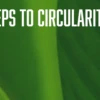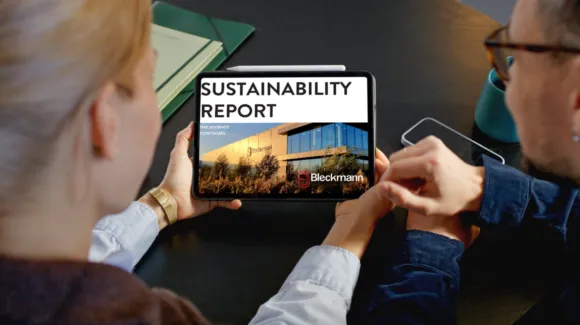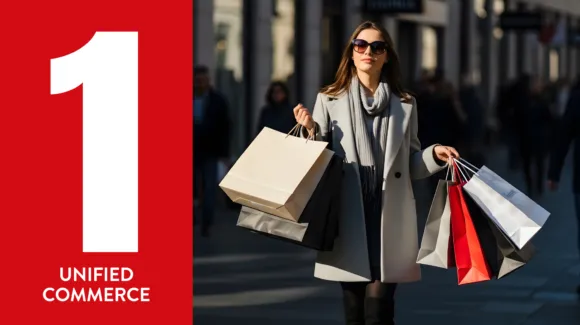Sustainability is no longer a side topic in e-commerce logistics — it is a core business priority. Governments are enforcing stricter environmental regulations, consumers increasingly expect responsible choices, and brands in fashion, lifestyle and beyond must demonstrate measurable progress on their ESG goals.
At the same time, global e-commerce continues to grow. Online sales are projected to exceed USD 8 trillion by 2027, representing over a quarter of all retail worldwide. Every order shipped from a fulfilment centre brings with it opportunities to reduce environmental and social impact — or risks of falling behind competitors who do.
What does this mean for brands and logistics providers? The industry is entering a new era—one where reuse, circular strategies, and data-backed fulfilment redefine value. Warehousing, shipping, and returns are no longer just efficiency questions—they’re central to how products retain value, comply with regulations (like EPR), and build customer trust.
This blog explores seven practical ways to make your outbound logistics more sustainable. The solutions range from packaging choices to last-mile innovation and social sustainability. Each strategy can help your brand reduce emissions, improve customer satisfaction, and align with the latest legislation.
1. Reducing and Reusing Packaging
Single-use plastics are disappearing fast, but the challenge goes beyond swapping plastic for cardboard. In 2025, customers increasingly look for minimal, recyclable or reusable packaging.
- Less packaging, smarter design: Fit-to-size packaging reduces void space, cutting down both material use and transport emissions.
- Reusable packaging systems: Market innovations and solutions that allow parcels to be returned and reused multiple times. Early adopters are seeing both cost benefits and higher customer loyalty.
- Circular materials: Biodegradable and recycled-content packaging is becoming standard, and new EU packaging regulations will soon require recyclability for most e-commerce formats.
Did you know? 45% of European online shoppers say they are more likely to buy from a brand that offers sustainable packaging.
2. Smarter Deliveries — Paid, Not “Free”
“Free” delivery and returns have a hidden cost: higher emissions. Customers who don’t pay for shipping are more likely to order multiple sizes, then return the rest.
In 2025, many brands are shifting toward paid delivery models, often combined with transparent communication about sustainability. This reduces unnecessary returns and creates room to invest in greener options such as carbon-neutral shipping or reusable packaging.
3. Optimising Fulfilment Operations for Lower Impact
Sustainability starts well before the last mile. The way fulfilment centres are designed and operated has a major influence on total emissions. At Bleckmann, we believe greener logistics begins at the source.
- Energy-efficient warehouses: Solar panels, LED lighting, and smart heating/cooling systems significantly cut emissions. Many of Bleckmann’s sites already run partly on renewable energy, with targets to expand further.
- Automation and efficiency: Smarter picking, packing and routing reduce waste, errors, and unnecessary transport. This directly lowers both costs and emissions.
- Strategic stock positioning: By placing inventory closer to the end consumer, delivery distances shrink. This not only reduces CO₂ but also speeds up service.
- Shared facilities: Multi-client warehouses allow brands to benefit from economies of scale in energy use, transport consolidation, and resource sharing.
Example: A lifestyle brand working with Bleckmann reduced average delivery distances by 18% by re-positioning stock across two fulfilment centres instead of one.
Optimising fulfilment operations may not be as visible to consumers as an electric van, but its impact is often larger. It also demonstrates that sustainability and operational excellence go hand in hand.
4. Partnering with Sustainable Carriers & Measuring Impact
Choosing the right carrier is one of the most effective ways to reduce the footprint of your deliveries. While many logistics providers are investing in electric fleets or alternative fuels, progress and commitment vary widely. Brands can make a real difference by working only with partners that share their sustainability goals.
- Carrier monitoring: Ask your logistics partners to provide transparent CO₂ reporting per parcel.
- Aligned targets: Work with carriers who commit to science-based targets, renewable energy adoption, and low-emission zones.
- Continuous improvement: Regularly review carrier performance and adjust contracts to incentivise greener behaviour.
Tip: Many brands now publish their logistics CO₂ footprint in annual sustainability reports. Having accurate, partner-verified data makes this not only easier, but also more credible.
Measuring and managing impact together with your logistics partners ensures sustainability is not just a promise, but a proven result.
5. Supporting Circularity, Renewal & Recommerce
In fashion and lifestyle, products don’t need to end their journey after one customer return. Increasingly, brands are embracing circular business models that give items a second life. Logistics is the backbone of making this shift work.
- Reverse logistics made efficient: Handling returns quickly, sustainably and cost-effectively reduces unnecessary waste and emissions.
- Renewal of fashion items: Returned garments can be inspected, cleaned, repaired or reconditioned to meet quality standards for resale. This avoids landfill and keeps valuable products in circulation.
- Recommerce solutions: Dedicated flows for resale — through brand-owned outlets, online marketplaces or rental platforms — create new revenue streams while lowering environmental impact.
- Material recovery: Packaging, hangers and textiles can be collected, sorted and reintroduced into the supply chain, further reducing virgin material use.
- Compliance with EPR: As Extended Producer Responsibility (EPR) and textile waste legislation expand in Europe, brands need fulfilment partners who can provide take-back schemes, repair capabilities, and reporting.
Example: Working with Bleckmann, a leading fashion brand introduced a recommerce channel where returned and renewed items were resold online. Within the first year, 30% of returned products were given a second life, reducing waste and driving incremental sales.
Circularity is more than sustainability — it’s a business opportunity. Renewal and recommerce help fashion brands extend product lifecycles, build deeper customer loyalty, and meet both environmental and regulatory expectations.
6. Innovation Through Automation & Data-Driven Logistics
Sustainability in logistics is not only about transport or packaging — it also depends on how warehouses and supply chains are managed. By combining automation with data-driven decision-making, fulfilment operations can significantly reduce their environmental footprint.
- Smarter warehouses: Automated picking and packing reduce errors, energy use and unnecessary shipments. Robotics can optimise movements inside the warehouse, lowering power consumption and labour intensity.
- Energy efficiency: Automation systems integrated with smart building management (e.g., lighting, heating, cooling) ensure resources are only used when needed.
- Data-driven logistics: Real-time data on inventory, orders and returns allows brands to optimise stock placement, consolidate shipments, and reduce empty space in trucks.
- Predictive insights: Using data analytics, brands can forecast demand more accurately, avoiding overproduction and unnecessary warehousing.
- Carbon dashboards: Logistics data can be translated into CO₂ insights, helping brands track progress against reduction targets and report transparently on Scope 3 emissions.
Innovation doesn’t always mean futuristic solutions — sometimes it’s about using today’s technology smarter. Automation and data-driven logistics help brands run leaner, greener operations that benefit both the planet and the bottom line.
7. Prioritising Social Sustainability
Sustainability is not only about carbon. The way people in the logistics chain are treated matters just as much to consumers and regulators. At Bleckmann, social responsibility is a cornerstone of our sustainability strategy. We:
- Provide fair contracts and long-term employment opportunities.
- Focus on inclusivity and diversity, offering jobs to people with barriers to the labour market.
- Ensure safe, supportive workplaces across all facilities.
Brands that work with socially responsible logistics partners can strengthen their reputation and meet the growing demand for ethical supply chains.
Conclusion: From Obligation to Opportunity
Sustainable fulfilment is no longer optional; consumers expect it, regulators enforce it, and brands that embrace it can turn it into a competitive advantage.
The good news: there are multiple levers to pull — from packaging and delivery models to electrification and social responsibility. The challenge is deciding where to start and how to scale.
At Bleckmann, we support fashion and lifestyle brands in building fulfilment operations that are both efficient and sustainable. From green packaging pilots to less impactful last-mile deliveries and inclusive workplaces, we combine innovation with practical implementation. With a strong commitment to sustainability, we help our clients reduce environmental impact, comply with ESG regulations, and build future-proof logistics solutions.
Let’s talk. Contact us to explore how we can make your fulfilment more sustainable — together.














